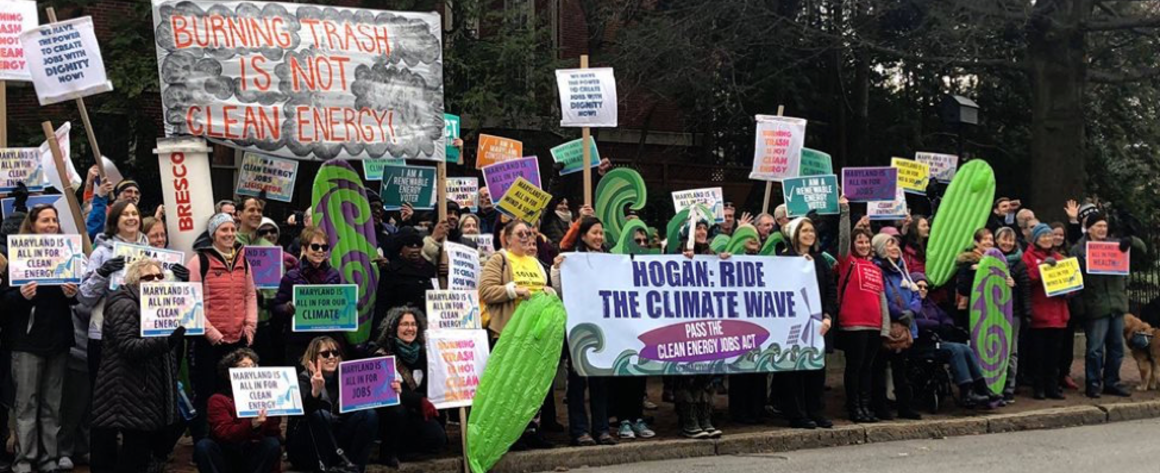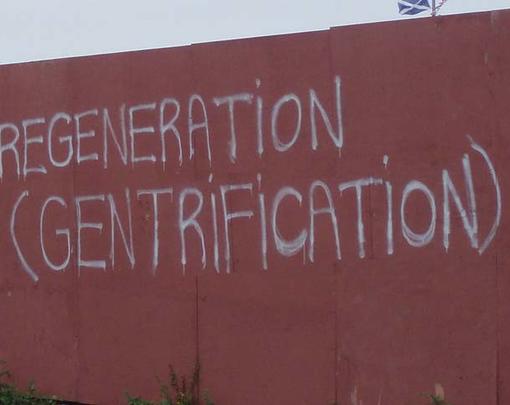Although media commonly highlight the severe challenges facing U.S. cities during the on-going COVID pandemic, there are many inspiring stories just below the radar screen. We are proud to be living in one of those cities—Baltimore—where a powerful, youth-led coalition helped spearhead the first Zero Waste Plan developed by and for U.S. grassroots communities.
Destiny Watford, a young organizer from Curtis Bay (a neighborhood in South Baltimore, Maryland) takes center stage at a youth-led forum on March 16, 2019 to propose that Baltimore City adopt Zero Waste alternatives which would transition us from an economy of extraction to one of reuse and regeneration. This was the culminating event for youth at Benjamin Franklin High School, a community school in South Baltimore, who had been working in a participatory action research class for over a year sketching ecologically and socially sustainable alternatives for fair development with architects, anthropologists, and community organizers.
From “Dumping Ground” to Grassroots Movement for Fair Development
Destiny, the keynote speaker, led the fight against the proposal to build the nation’s largest trash-burning incinerator in Curtis Bay, and as a result, won a Goldman Prize, a global award for environmental leaders. She emphasized to the audience:
Land in our community has [historically] been used as [a] tool for exploitation and control. Some neighborhoods get resources while others get disinvestment based on race and poverty. Some get developed; others get the waste products of that development. One of the largest threats to our air and environment here in Baltimore is the BRESCO incinerator, which creates one-third of the air pollution in the city and adds to the pollution that we already have in our neighborhood. BRESCO is located in South Baltimore; that isn’t by accident. South Baltimore is considered to be the dumping ground of our city and it must end.
Destiny highlighted the ways in which land in her community had become the dumping grounds for polluting industries. Home to two medical waste incinerators, a landfill, an open-air coal pier, and several chemical and fertilizer companies, Curtis Bay could be described as one of the most environmentally unhealthy and uninhabitable places in Baltimore. As Physicians for Local Responsibility (a group of socially conscious physicians who have worked on anti-incinerator campaigns in Baltimore) have made increasingly clear, incineration puts pollutants into the air, soil, and water. The fine particulate matter released from incinerators and other toxic stationary facilities called PM2.5 often get lodged in the airways and can cause breathing ailments, lung cancers, and other respiratory illnesses. And especially relevant now, a recent Harvard study found that a small increase in long-term exposure to PM2.5 leads to a large increase in COVID-19 related deaths.
Due to the cumulative effects of toxic industries housed in this Southern region of Baltimore, Curtis Bay has the highest rates of asthma—more than any other zip code in the U.S.The local high school was so affected by the asthma crisis that it didn’t have enough young women without respiratory illness to comprise a women’s basketball team.
Setting the Stage: The Power of Curtis Bay Students
When youth in 2012 read an article in the Baltimore Brew indicating that the City planned to build the nation’s largest trash-to-energy incinerator less than a mile from their school, they organized a massive campaign to end the proposal. While many in the Curtis Bay neighborhood association saw the trash-to-energy proposal as an opportunity to bring jobs to a deindustrialized and depressed area of Baltimore, youth attending Benjamin Franklin High School were not duped into believing the simple dichotomy between jobs and the environment. Through systemic research, they uncovered that the toxins that would be released into their air— lead and mercury along with fine particulate matter—would further exacerbate respiratory illness in their community. As they read about the history of their community, they realized this proposal was part of a longer history of using Curtis Bay as a “dumping ground” to house or burn garbage from wealthier and more affluent parts of the city.
Free Your Voice, which began as an informal afterschool program inside Benjamin Franklin High School through United Workers (a Baltimore-based nonprofit organization focused on human rights), evolved into a powerful youth-led movement to end incineration in Baltimore. The group organized from 2012-2015 by door-knocking and informing the broader community of the City’s proposal and the public health threats it posed. They wrote letters to public officials, collected photos as well as thousands of signatures for a “photo petition,” and held a massive “Stop the Incinerator” march.
Unable to rally enough support to end the City’s plan, the group shifted its strategy towards disinvestment. More specifically, by encouraging public entities not to buy “dirty energy,” they worked to end the project by making it unprofitable. Early organizing strategies included song and protests, and once Baltimore City Public Schools withdrew from its contract in spring 2015, Free Your Voice escalated its tactics and organized a massive demonstration in front of the Maryland Department of the Environment, where seven protestors were arrested for civil disobedience (Shen, 2012). When the group’s efforts finally spurred Baltimore City to terminate its contract in March of 2015, the youth organizers knew they had to propose a new system of economic development in place of the dirty, extractive industries that took a serious toll on their health.
Fair Development and Launching the Zero Waste Plan
Baltimore’s Zero Waste Plan underscores the importance of fair development, an idea that came out of earlier conversations within the Baltimore Housing Roundtable (now the Fair Development Roundtable), a group formed to create “development without displacement” and promote community development that “highlights [the] key benefits of community ownership strategies” (read their full report here). The plan also involved significant community input: in summer 2019, the Fair Development Roundtable, along with Zero Waste Associates and the Institute for Local Self-Reliance, surveyed residents to better understand the impact that waste and incineration have on communities. Many people highlighted structural inequities: lacking basic trash cans and recycling bins, not having their garbage picked up, outsiders using their communities as dumping grounds, and the health impacts of incineration. The team also surveyed community partners such as faith institutions, community development corporations, social service agencies, and larger anchor institutions (e.g., universities) to understand their vision for Zero Waste.
This participatory process led to an extensive report entitled “Baltimore’s Fair Development Plan for Zero Waste,” which was released by United Workers in spring 2020. If implemented, this will be the first Zero Waste plan for “Fair Development” crafted by and for grassroots communities in the U.S. Like broader national conversations around a Green New Deal, this plan lays out how Baltimore can create a just transition from an economy of extraction to that of reuse and regeneration. More specifically, it outlines the priorities of a Zero Waste system and how to achieve clean air, community power, less waste, clean communities, and more jobs. It calls for 90% of all materials discarded in the city to be diverted from landfills and incinerators by 2040, and for the City to contract with mission-based or worker-owned recycling and compost operators, and enterprises that hire local residents and pay family-sustaining wages. It also promises to establish a close partnership between elected officials, public housing and school systems, community groups, businesses, and universities and other anchor institutions throughout Baltimore City and County.
Next Goliath Is BRESCO
In March of 2020, Baltimore’s City Council unanimously voted to support the Zero Waste Resolution. This, however, has not resulted in the end of residents’ challenges, as there is another “Goliath” in the community: BRESCO. Founded twenty years ago, the Baltimore Refuse Energy Systems Company (BRESCO) is a large waste-to-energy incinerator. BRESCO is the 10th-largest trash incinerator in the country and accounts for 36% of all air emissions from Baltimore City industry, three times worse than the second-largest polluter. Its facilities are outdated and are estimated to pump out twice the pollution as similarly sized facilities (Dance, 2017). The majority of the waste that sustains BRESCO comes from Baltimore County, which is consistent with a pattern of inequity in consumption contributing to air pollution in Black and Brown communities (Tessum et al, 2019).
Facing the Zero Waste Resolution and Baltimore’s 2019 Clean Air Act, a law that requires the city’s large waste incinerators to meet the most protective air pollution standards, the incineration industry is fighting to maintain its business interests in Baltimore. Wheelabrator (the company that owns BRESCO) sent many mailings to residents to lobby against the law, saying that “the Clean Air Act is not a solution.” In late April 2019, Wheelabrator, Curtis Bay Energy, and two industry trade associations sued the City claiming that the City doesn’t have the authority to pass The Clean Air Act. While the City’s legal case was strong, the federal court ruled on March 27, 2020, to strike down the City law because it conflicts with state law. On April 6, 2020, the City Council unanimously adopted a resolution after a virtual press conference with youth from Curtis Bay and allies across the city calling on the City to appeal the ruling.
Just a week before the 30-day deadline to appeal, Baltimore City Mayor Jack Young was wavering. Recognizing that without the Clean Air Act, the prospect of closing the incinerator was severely endangered, the coalition pushing to close the incinerator and adopt Zero Waste took swift action to pressure Mayor Young to appeal the ruling. On the 50th anniversary of Earth Day, the Zero Waste team held a press conference to draw attention to this issue. The same day, the group held a CDC-approved, socially distant “die-in” in front of the BRESCO smokestacks to draw attention to the deadly impacts—particularly in light of COVID-19—of air pollution on surrounding communities. As protesters were leaving the action, they got word that the City had filed the appeal and the fight would continue.
To keep the momentum going, in April of 2020, the Zero Waste team used an illuminator on BRESCO’s smokestack to project the words that community residents felt represented incineration, from “toxic” to “public health crisis” to “I cannot breathe.” This tactic allowed activists to transform spaces of capital accumulation into sites of engagement, conflict, and dialogue.
As Baltimore is now in an election year, the Zero Waste organizers conducted a series of interviews with a myriad of candidates (mayoral, city council, and comptroller) to gauge their support for shutting down the incinerator and adopting Zero Waste. Most of the candidates strongly support closing BRESCO, a tool that can be used in the future to push the city leadership to prioritize these efforts. However, the group is well aware of discrepancies between verbal support for Zero Waste and actual City budgets. Demonstrating this, Baltimore’s FY2020 budget proposes to direct $509 million to the police department, more than three times the combined amount proposed for housing and community development, employment development, homeless services, recreation and parks, art and culture, health, and civil rights.
Moving Forward: Now is the Time
Free Your Voice began with a focus on the right to breathe clean air. COVID-19 and violent policing have made it increasingly visible that “the right to breathe” is a broader concern for young Black and Brown people across the country.
If the massive uprisings in U.S. cities illustrate anything, now is the time to defund the police and for City officials to redirect resources towards community organizations with concrete plans for housing and environmental justice. It is unclear, however, whether and how the street-level protests will funnel the same explosive energy into grassroots organizing to pressure City officials to actually reallocate wealth and resources to low-income Black and Brown communities. As the monuments of white supremacy fall, let the structural inequities that have historically existed in U.S. cities simultaneously be dismantled, and let us collectively push for city-wide investments in quality housing, decent healthcare for all, education, and Zero Waste jobs as we implement plans for fair development.





